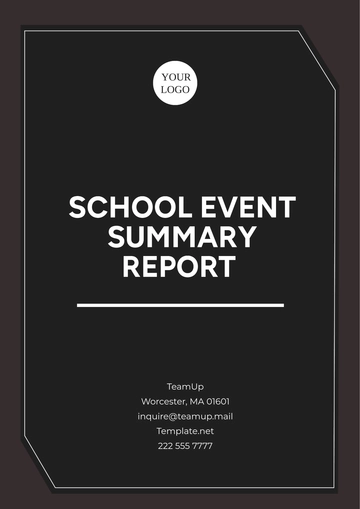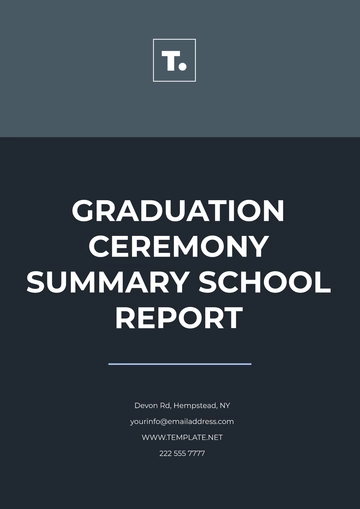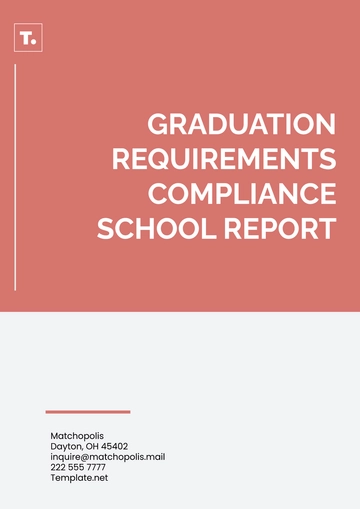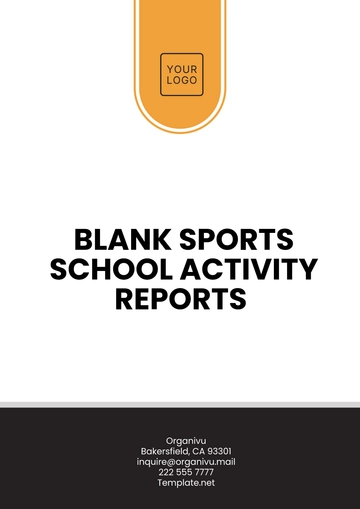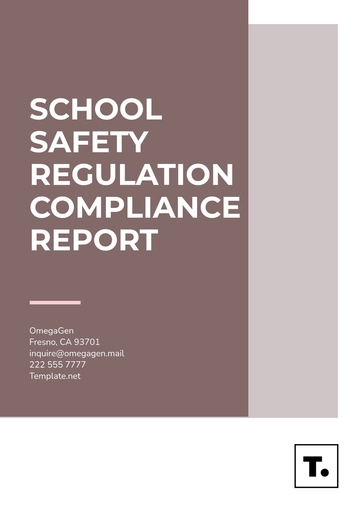Free School Grade Report

I. Introduction
A. Purpose
Overview of Objectives: This grade report aims to provide a comprehensive overview of the academic performance of Grade 5 students at [Your Company Name] for the school year 2054-2055. It details individual and collective achievements across all subjects.
Importance of Assessment: Accurate assessment is crucial for understanding student progress, identifying areas of improvement, and guiding instructional strategies to enhance learning outcomes.
Stakeholder Information: The report is intended for students, parents, teachers, and school administrators to ensure transparency and foster a collaborative approach to education.
B. Scope
Subjects Covered: This report covers all core subjects taught in Grade 5, including Mathematics, Science, English Language Arts, Social Studies, and Physical Education.
Evaluation Criteria: The evaluation criteria include tests, quizzes, assignments, class participation, and projects, providing a holistic view of student performance.
Reporting Period: The report covers the entire school year from September 2054 to June 2055, encompassing all major assessments and academic activities.
C. Methodology
Data Collection: Data was collected through regular assessments, standardized tests, classroom observations, and teacher evaluations. This ensures a comprehensive and accurate measurement of student performance.
Grading Scale: The grading scale follows the standard A-F format, with A representing excellent performance and F indicating a need for significant improvement.
Student Engagement: Emphasis is placed on student engagement and effort, recognizing the importance of participation and active learning in academic success.
II. Student Performance Summary
The following table provides an overview of the average grades for each subject for all students in Grade 5:
Student Name | Mathematics | Science | English Language Arts | Social Studies | Physical Education |
|---|---|---|---|---|---|
Anderson, John | A | B+ | A- | B | A |
Brown, Emily | B+ | A | A | A- | B+ |
Carter, Olivia | A- | B | B+ | A | A- |
Davis, Michael | B | B+ | B | B | A |
Evans, Sophia | A | A | A | A- | A |
Garcia, Jacob | A- | B+ | B | B+ | B+ |
Harris, Mia | B+ | A- | A- | B+ | A |
Jackson, Noah | A- | B | B+ | B | B+ |
King, Isabella | A | A | A- | A | A |
Lee, Mason | B | B+ | B | B- | B |
Martinez, Ava | A- | A- | B+ | B+ | A |
Nelson, Lucas | B+ | B | B | B- | A- |
Robinson, Lily | A | B+ | A- | B+ | A |
Scott, James | B | B | B- | B | B+ |
Taylor, Charlotte | A- | A | A | A | A |
A. Mathematics
High Achievers: Students like John Anderson and Sophia Evans demonstrated exceptional mathematical skills, consistently scoring high on tests and assignments.
Areas of Improvement: Students such as Michael Davis and Mason Lee showed steady progress but require additional support in specific areas like algebra and geometry.
Teaching Strategies: The use of interactive tools and real-life problem-solving exercises has proven effective in enhancing student engagement and understanding of mathematical concepts.
B. Science
Outstanding Performance: Emily Brown and Isabella King excelled in science, showing a deep understanding of scientific principles and strong analytical skills.
Support Needed: Jacob Garcia and Noah Jackson could benefit from additional hands-on experiments and visual aids to improve comprehension and retention of scientific knowledge.
Innovative Approaches: Incorporating more project-based learning and collaborative experiments can further stimulate interest and improve performance in science.
C. English Language Arts
Excellent Writers: Olivia Carter and Charlotte Taylor displayed exceptional writing and comprehension skills, often exceeding expectations in their assignments and tests.
Focus Areas: James Scott and Lucas Nelson need targeted support in reading comprehension and essay writing to achieve better outcomes.
Effective Methods: Implementing peer review sessions and providing diverse reading materials have positively impacted student performance in English Language Arts.
D. Social Studies
Top Performers: Ava Martinez and Emily Brown consistently scored high in social studies, demonstrating a strong grasp of historical events and civic understanding.
Additional Help: Mason Lee and Michael Davis need more interactive activities like debates and role-playing to engage better with the subject matter.
Enhanced Learning: Using multimedia resources and connecting historical events to current issues can make social studies more relatable and engaging for students.
E. Physical Education
Active Participants: John Anderson and Mia Harris showed excellent physical fitness and sportsmanship, participating actively in all physical education activities.
Encouragement Needed: Lucas Nelson and James Scott could benefit from more encouragement and structured physical activities to improve their fitness levels.
Holistic Approach: Emphasizing the importance of physical health and incorporating a variety of sports can enhance overall student participation and enjoyment in physical education.
III. Attendance and Participation
The following table summarizes the attendance and participation rates for each student:
Student Name | Attendance | Participation Rate |
|---|---|---|
Anderson, John | 98% | 95% |
Brown, Emily | 97% | 98% |
Carter, Olivia | 96% | 93% |
Davis, Michael | 94% | 90% |
Evans, Sophia | 99% | 97% |
Garcia, Jacob | 95% | 92% |
Harris, Mia | 97% | 94% |
Jackson, Noah | 94% | 89% |
King, Isabella | 98% | 96% |
Lee, Mason | 93% | 88% |
Martinez, Ava | 97% | 95% |
Nelson, Lucas | 92% | 85% |
Robinson, Lily | 98% | 94% |
Scott, James | 93% | 86% |
Taylor, Charlotte | 99% | 98% |
A. Attendance Analysis
High Attendance: Students like Sophia Evans and Charlotte Taylor maintained nearly perfect attendance, demonstrating their commitment to their education.
Improvement Needed: Lucas Nelson and Mason Lee had lower attendance rates, which may have impacted their overall academic performance.
Strategies for Improvement: Implementing attendance incentives and providing additional support for students with attendance challenges can help improve overall attendance rates.
B. Participation Analysis
Engaged Students: Emily Brown and Isabella King consistently participated in class activities, contributing positively to the learning environment.
Increased Engagement: Noah Jackson and James Scott showed lower participation rates, indicating a need for strategies to increase their engagement in class activities.
Encouraging Participation: Creating a more interactive and inclusive classroom environment can encourage greater participation from all students.
C. Correlation with Performance
Positive Correlation: There is a noticeable positive correlation between high attendance and participation rates and overall academic performance.
Addressing Disparities: Identifying and addressing the reasons for lower attendance and participation can help improve academic outcomes for affected students.
Comprehensive Approach: A comprehensive approach that includes academic support, counseling, and parental involvement can enhance both attendance and participation rates.
IV. Extracurricular Activities
The following table outlines the extracurricular activities and student involvement for the school year 2054-2055:
Student Name | Sports Teams | Clubs/Organizations | Leadership Roles |
|---|---|---|---|
Anderson, John | Soccer, Basketball | Science Club | Class Representative |
Brown, Emily | Volleyball | Debate Team | Club President |
Carter, Olivia | Track and Field | Drama Club | Event Coordinator |
Davis, Michael | Baseball | Math Club | Treasurer |
Evans, Sophia | Tennis | Art Club | Secretary |
Garcia, Jacob | Swimming | Chess Club | Vice President |
Harris, Mia | Gymnastics | Music Club | Member |
Jackson, Noah | Soccer | Robotics Club | Member |
King, Isabella | Basketball | Environmental Club | Member |
Lee, Mason | Baseball | Yearbook Committee | Member |
Martinez, Ava | Volleyball | Science Club | Member |
Nelson, Lucas | Track and Field | Drama Club | Member |
Robinson, Lily | Tennis | Debate Team | Member |
Scott, James | Swimming | Robotics Club | Member |
Taylor, Charlotte | Gymnastics | Art Club | Member |
A. Extracurricular Engagement
Broad Participation: A significant number of students participated in multiple extracurricular activities, showcasing their diverse interests and talents.
Leadership Roles: Several students held leadership roles, demonstrating strong organizational and leadership skills that are beneficial for their overall development.
Balance with Academics: Active involvement in extracurricular activities did not negatively impact academic performance, indicating effective time management skills among students.
B. Benefits of Extracurricular Activities
Skill Development: Participation in sports and clubs helps students develop essential skills such as teamwork, leadership, and time management, which are valuable for their future endeavors.
Social Interaction: Extracurricular activities provide opportunities for students to interact with peers, fostering social skills and building lasting friendships.
Holistic Education: Engaging in a variety of activities contributes to a well-rounded education, promoting physical, emotional, and intellectual growth.
C. Encouragement for Participation
Incentives and Support: Providing incentives and support for students to join extracurricular activities can increase participation rates and enhance the overall school experience.
Parental Involvement: Encouraging parental involvement in extracurricular activities can further motivate students and provide additional support for their endeavors.
Expanding Opportunities: Continuously expanding the range of extracurricular activities offered can cater to diverse interests and encourage more students to get involved.
V. Student Behavior and Conduct
The following table summarizes the behavior and conduct records for each student:
Student Name | Conduct Grade | Discipline Incidents | Positive Behavior Reports |
|---|---|---|---|
Anderson, John | A | 0 | 5 |
Brown, Emily | A | 1 | 4 |
Carter, Olivia | B+ | 2 | 3 |
Davis, Michael | B | 3 | 2 |
Evans, Sophia | A | 0 | 6 |
Garcia, Jacob | B+ | 1 | 3 |
Harris, Mia | A | 0 | 5 |
Jackson, Noah | B | 3 | 2 |
King, Isabella | A | 0 | 5 |
Lee, Mason | B | 2 | 3 |
Martinez, Ava | A | 0 | 4 |
Nelson, Lucas | B+ | 1 | 3 |
Robinson, Lily | A | 0 | 5 |
Scott, James | B | 2 | 2 |
Taylor, Charlotte | A | 0 | 6 |
A. Conduct Analysis
Excellent Conduct: Students such as John Anderson, Sophia Evans, and Charlotte Taylor exhibited excellent conduct, with high grades and multiple positive behavior reports.
Behavioral Challenges: Michael Davis and Noah Jackson had more discipline incidents, indicating areas where additional behavioral support may be needed.
Positive Reinforcement: Recognizing and rewarding positive behavior is essential for encouraging good conduct and creating a supportive school environment.
B. Behavior Support Strategies
Behavioral Interventions: Implementing targeted behavioral interventions for students with recurring discipline incidents can help address underlying issues and promote positive behavior.
Counseling Services: Providing access to counseling services can support students in managing their behavior and improving their overall conduct.
Parental Collaboration: Collaborating with parents to address behavioral challenges can provide a consistent approach to behavior management both at school and home.
C. Positive Behavior Reinforcement
Recognition Programs: Establishing recognition programs for positive behavior can motivate students to maintain good conduct and strive for excellence.
Incentive Systems: Implementing incentive systems that reward positive behavior can encourage students to adhere to school rules and exhibit good conduct.
Role Models: Encouraging students to act as role models for their peers can foster a culture of positive behavior and mutual respect within the school.
VI. Academic Support and Interventions
The following table outlines the academic support and intervention programs provided during the school year:
Program | Description | Students Involved | Outcomes Achieved |
|---|---|---|---|
Tutoring Sessions | One-on-one tutoring for struggling students | 5 | Improved grades, confidence |
Remedial Classes | Extra classes for students needing support | 7 | Better understanding |
Enrichment Programs | Advanced programs for high-achieving students | 6 | Enhanced skills, knowledge |
A. Tutoring Sessions
Targeted Support: Tutoring sessions provided targeted support for students struggling with specific subjects, helping them improve their grades and build confidence in their abilities.
Personalized Approach: The one-on-one nature of tutoring allowed for a personalized approach, addressing individual student needs and learning styles.
Positive Outcomes: Students who participated in tutoring sessions showed significant improvement in their academic performance and a greater willingness to engage in class activities.
B. Remedial Classes
Extra Assistance: Remedial classes offered extra assistance to students who needed additional support to keep up with the curriculum, ensuring they did not fall behind.
Collaborative Learning: These classes fostered a collaborative learning environment, where students could learn from each other and receive guidance from teachers.
Better Understanding: Students who attended remedial classes demonstrated a better understanding of challenging concepts and were able to perform better in assessments.
C. Enrichment Programs
Advanced Learning: Enrichment programs provided opportunities for high-achieving students to delve deeper into subjects and explore advanced topics, enhancing their skills and knowledge.
Motivational Impact: These programs served as a motivational tool, encouraging students to strive for excellence and pursue their academic interests with enthusiasm.
Skill Development: Participants in enrichment programs developed critical thinking and problem-solving skills, which are valuable for their future academic and career endeavors.
VII. Recommendations
A. Academic Recommendations
Individualized Learning Plans: Implement individualized learning plans for students to cater to their unique strengths and areas for improvement. This will ensure personalized support and targeted interventions.
Professional Development: Provide ongoing professional development opportunities for teachers to stay updated with the latest educational strategies and technologies. This will enhance their instructional skills and improve student outcomes.
Parental Involvement: Increase parental involvement in the educational process through regular communication, workshops, and collaborative activities. This will foster a supportive learning environment both at school and home.
Extracurricular Expansion: Expand the range of extracurricular activities offered to cater to diverse student interests and talents. This will encourage greater participation and holistic development.
B. Behavioral Recommendations
Positive Behavior Programs: Implement positive behavior programs that recognize and reward good conduct. This will motivate students to maintain high standards of behavior and create a positive school culture.
Counseling Services: Enhance access to counseling services for students to support their emotional and behavioral well-being. This will help address underlying issues and promote positive behavior.
Parental Collaboration: Foster strong collaboration with parents to address behavioral challenges and provide consistent support for students. This will ensure a unified approach to behavior management.
Peer Mentoring: Establish peer mentoring programs where older students can guide and support younger students. This will promote a sense of responsibility and leadership among students.
VIII. Conclusion
The School Grade Report of [Your Company Name]'s Grade 5 students for the school year 2054-2055 highlights the achievements and areas for improvement. Through detailed analysis of academic performance, attendance, participation, and behavior, we have identified key strengths and challenges that will guide our future efforts.
By implementing the recommendations outlined in this report, we can enhance the learning experience for our students, foster a positive school culture, and support the holistic development of every student at [Your Company Name]. We look forward to building on these insights and working collaboratively with students, parents, and staff to achieve our educational goals.
- 100% Customizable, free editor
- Access 1 Million+ Templates, photo’s & graphics
- Download or share as a template
- Click and replace photos, graphics, text, backgrounds
- Resize, crop, AI write & more
- Access advanced editor
Streamline grading with the School Grade Report Template! Available on Template.net, this template is fully editable and customizable to suit your grading needs! The AI Editor Tool helps to ensure accuracy and clarity in your grade reports, making it easier to communicate students' performance effectively. Revolutionize grading reporting right away!
You may also like
- Sales Report
- Daily Report
- Project Report
- Business Report
- Weekly Report
- Incident Report
- Annual Report
- Report Layout
- Report Design
- Progress Report
- Marketing Report
- Company Report
- Monthly Report
- Audit Report
- Status Report
- School Report
- Reports Hr
- Management Report
- Project Status Report
- Handover Report
- Health And Safety Report
- Restaurant Report
- Construction Report
- Research Report
- Evaluation Report
- Investigation Report
- Employee Report
- Advertising Report
- Weekly Status Report
- Project Management Report
- Finance Report
- Service Report
- Technical Report
- Meeting Report
- Quarterly Report
- Inspection Report
- Medical Report
- Test Report
- Summary Report
- Inventory Report
- Valuation Report
- Operations Report
- Payroll Report
- Training Report
- Job Report
- Case Report
- Performance Report
- Board Report
- Internal Audit Report
- Student Report
- Monthly Management Report
- Small Business Report
- Accident Report
- Call Center Report
- Activity Report
- IT and Software Report
- Internship Report
- Visit Report
- Product Report
- Book Report
- Property Report
- Recruitment Report
- University Report
- Event Report
- SEO Report
- Conference Report
- Narrative Report
- Nursing Home Report
- Preschool Report
- Call Report
- Customer Report
- Employee Incident Report
- Accomplishment Report
- Social Media Report
- Work From Home Report
- Security Report
- Damage Report
- Quality Report
- Internal Report
- Nurse Report
- Real Estate Report
- Hotel Report
- Equipment Report
- Credit Report
- Field Report
- Non Profit Report
- Maintenance Report
- News Report
- Survey Report
- Executive Report
- Law Firm Report
- Advertising Agency Report
- Interior Design Report
- Travel Agency Report
- Stock Report
- Salon Report
- Bug Report
- Workplace Report
- Action Report
- Investor Report
- Cleaning Services Report
- Consulting Report
- Freelancer Report
- Site Visit Report
- Trip Report
- Classroom Observation Report
- Vehicle Report
- Final Report
- Software Report





